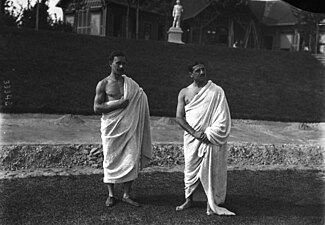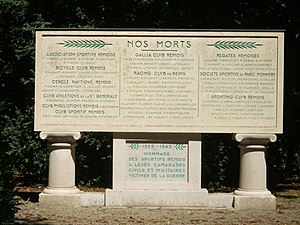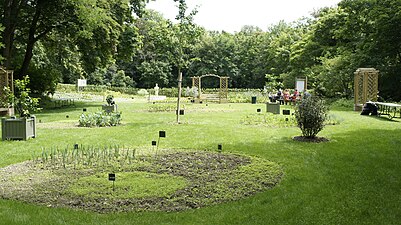Draft:Parc de Champagne
The content of this article is translated from the existing French Wikipedia article at fr:Parc de Champagne; see its history for attribution.
| Parc de Champagne | |
|---|---|
 | |
| Type | Jardin à l'anglaise |
The Parc de Champagne (formerly Parc Pommery) is a landscaped area in the French town of Reims. It was created by Marquis de Polignac for the well-being of his employees working in the cellars and also to leave his mark on Reims[1]. It is located on Avenue du Général-Giraud.
History
[edit]-
The Athletes' College...
-
... ...now disappeared.
-
Stele to Georges Hébert.
-
Entrance pavilion.
Work began in 1909, and the park was opened to workers in 1911[2]. It was then inaugurated on 19 October 1913 by President Raymond Poincaré. Originally, it was a park on the heights of Reims and close to the vineyards and Pommery cellars. It served as a relaxation area for Pommery employees and was later developed as a sports venue by the Marquis in 1913, with the Athletes' College, the first physical education center in France, the birthplace of hébertisme which was practiced there at the beginning of the century. The greatest athletes, including Jean Bouin, trained there using Georges Hébert's methods. On 23 July 1912, it hosted the North American delegation returning from the fifth Olympiad. They had been the top nation in athletics medals at Stockholm.
Having suffered extensive damage during World War I, the park was rebuilt by Edouard Redont and Ernest Kalas.
Activities
[edit]The park hosts numerous sports activities, equestrian competitions (Jumping international de Reims), and cultural events, such as the picnic concert of the Flâneries musicales de Reims. A children's playground is permanently open to the public. Herb gardens, photography exhibitions, and a beach volleyball area are thematic activities held in the park. The annual cultivation of an herb garden also takes place. Parc de Champagne is a place focused on relaxation, a wooded park where it is pleasant to stroll. It is also open to animals: a canine area is installed, allowing dogs to roam freely under their owner's supervision.
Visitors enjoy free admission to this large park, which was paid until a few years ago[3].
World War I Memorial
[edit]The park features the new Monument to the Heroes of the Black Army, commemorating the African colonial troops enlisted in the French army during World War I. This monument replaces the one erected during the interwar period and destroyed by the Germans during World War II in September 1940. The original monument was located at the corner of Boulevard Henri-Vasnier and the road to Châlons. An identical monument is located in Bamako, Mali.
There is also a memorial to the members of the sports clubs who died in World War I.
Protection
[edit]-
General plan for construction.
-
Hébert's training in 1913.
-
Memorial.
-
Horse contest.
-
Simple garden at Parc de Champagne in 2012.
-
Concert of theMusical strolls in Reims.
Bibliography
[edit]- Christophe Henrion and Tony Froissart eds. ''Le culte du corps et de l'esprit: le Collège d'athlètes de Reims'', épure, 2014.
Internal links
[edit]- Reims
- History of Reims
- History of sports
- Place of memory
- Places of memory of the First World War
- List of parks and public gardens in France
References
[edit]- ^ "Le parc de Champagne". www.reims.fr (in French). Retrieved 2017-03-31.
- ^ Gracia Dorel-Ferré (September 2016). Les mémoires de l'industrie en Champagne-Ardenne. Lyon: Lieux-Dits. p. 196-200, Sport et industrie: le cas de la Maison Pommery, by Christophe Henrion. ISBN 978-2-36219-141-1.
{{cite book}}: Unknown parameter|total pages=ignored (help) - ^ "Le parc de Champagne # Bonnes Adresses Rémoises". bonnesadressesremoises.fr (in French). Retrieved 2017-03-31.











